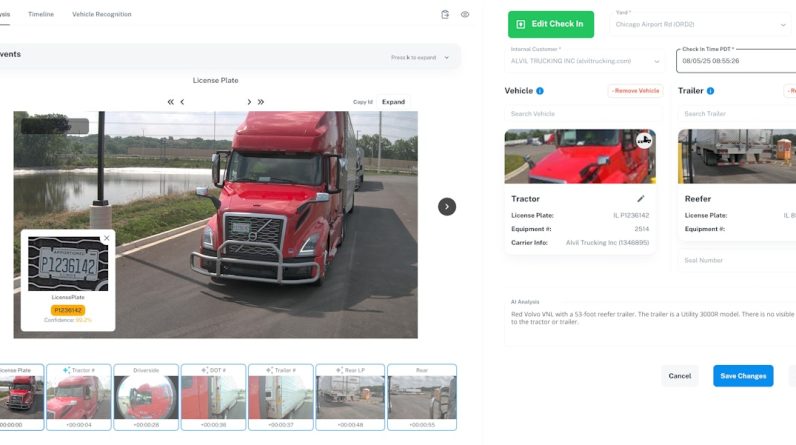
License plate numbers, truck and trailer numbers, DOT numbers, vehicle make, model, color, company logos and more – these are all data points recorded when a truck and trailer come through a gate at a facility.
But gate guards achieve only about 85% accuracy when recording this data, and there are many additional challenges to manual gate operations.
That’s why Outpost, an owner and operator of more than 20 truck terminals and drop yards, built its own AI-powered gate automation platform to eliminate the human element almost entirely. The company trained and tested the platform across more than 1 million gate events at its properties, and now is making it available to the market at large: shippers, enterprise fleets and terminal operators across the U.S.
[RELATED: AI & ML camera technology aims to improve logistics yards]
“We couldn’t find something on the market; we had to build it to meet our requirements,” said Outpost Chief Technology Officer Greg Akselrod. “As the story goes, our customers were using it and benefiting from the data – seeing the imagery of their trucks coming in and out – and they approached us and said, ‘This is something we could use at our facilities, too.’”
Special specifications
Outpost provides the hardware, software, civil planning, installation and ongoing remote operations services for its platform, which uses computer vision, voice, AI and remotely located human agents.
Akselrod said the default installation (or most common install) is a single post with a camera at the site of the gate that has everything needed to fully inspect the truck and trailer and interact with the driver. The company’s goal is to have an “extremely light footprint,” but it also offers optional add-ons.
Customers can choose to install additional cameras. For example, if they want inspection of tires, Outpost can provide a lower camera or a passenger side camera for inspection – anywhere up to a 360-degree view of the vehicle.
Akselrod said part of the reason Outpost built its own platform is because the company wasn’t getting accurate enough results from off-the-shelf solutions. He said this system doesn’t just look at numbers on the vehicle and trailer character-by-character to try to read it.
The system uses the context of the whole frame as well as multiple camera angles as vehicles come through in the event of an obstruction like dirt on a license plate or a mirror blocking part of a label. It can also glean context clues from imagery of equipment that it has seen in the past.
“It’s much the way that a human would. It’s like, if you can’t see it, you’re going to wait until it comes through a little bit, or you’re going to use other context clues to get that accuracy,” Akselrod said. “That’s how we’ve been able to get our recognition accuracy north of 99%.”
Data behind the gate
Gate operations have always been a necessary cost center in the supply chain with costs just to staff the gate with a guard running upwards of $25,000 a month, based on Outposts data. And gate guards are only about 85% accurate, Akselrod said.
This platform uses computer vision and AI to cut gate operating costs by 70%, improve yard security, eliminate entry and exit delays and automatically capture 99.9% of gate events with accurate, auditable data.
This solution is fully automated, replacing gate guards altogether, while providing greater data insights.
Akselrod said there are several types of data they can gather:
• Structured operational data: identifying the driver behind the wheel, the tractor and trailer, time of entry/exit, etc., enabling the carrier to update customers on the progress of a load.
• Inspection data: identifying scratches, dents, missing mudflaps, etc. to report to maintenance. The system flags those items so the next time that vehicle and trailer return home, they can play a message for the driver that asks them to proceed to the maintenance shop for service.
• Raw imagery: recording video or images in the event of an accident that enables higher success rates for insurance claims.
Outpost integrates with its customers transportation and yard management systems to communicate this data.
“You get tires that can get out on the road that can create safety incidents and claims missed, red tags or out-of-service equipment, theft and fraud, people just tailgating through the gate or not catching somebody who is taking a trailer that’s not theirs. Also honest mistakes of a driver taking the wrong trailer and then not figuring it out until maybe they get to the destination,” Akselrod said. “It creates operational inefficiency; claims of insurance … and then just the delays of having to go through manual check-in processes. Those add up, and every minute counts.”
Nationwide, these inefficiencies contribute to more than $6.7 billion in avoidable costs each year.
The platform covers 20 points of detection, recognition and inspection to address these issues. It’s built to understand every vehicle, driver, document and anomaly and continuously learn and improve with each gate event.
Key capabilities include:
• Multi-part Vehicle Identification – Detecting vehicle type, make, model, color, trailer class, and fuel type.
• ID and Compliance Recognition – Reading USDOT and MC numbers, license plates, trailer and container IDs, chassis markings, hazmat placards, red tags, and company logos.
• Damage and Safety Inspection – Detecting dents, rust, scratches, broken lights, missing mud flaps, tire tread and sidewall issues, improper driver safety gear, and dashboard obstructions.
• Security Verification – Identifying seal presence, confirming driver identity through face-to-ID matching, validating license authenticity, and flagging tractor-trailer misdispatches.
• Situational Awareness – Tracking equipment movement, speed, full stops, tailgates, and gate malfunctions.
• Document and Cargo Intelligence – Extracting data from bills of lading and similar paperwork; detecting trailer and container cargo.
• Custom Detection – Outpost can train custom models for terminal-specific risks and SOP enforcement.
Outpost’s platform capabilities enable drivers to enter and exit the yard without stopping while terminal operators still capture all data required for operations and security compliance.
The platform also uses AI voice agents at the gate that are capable of greeting each driver, administering standard operating procedures (SOPs), answering questions and issuing site-specific instructions. Drivers can interact naturally in their native language without the need for apps or manually entering keycodes. For the remaining 1% of edge cases where a driver would need to speak to a human, Outpost can connect the driver to its remote operating center.
Outpost has worked with fleets like Werner Enterprises (CCJ Top 250, No. 14) to implement its gate automation system at their sites.
“Outpost is taking the pain out of gate operations,” said Ryan Gass, vice president of safety, terminal management, security and facilities maintenance at Werner. “Our drivers get through faster, our teams have better visibility, and our equipment is more secure. Using the platform at Outpost and our own terminals gives us cleaner data, faster terminal throughput and a unified view of our fleet across Werner and Outpost sites. They’re setting a new standard for how all modern facilities should run.”








